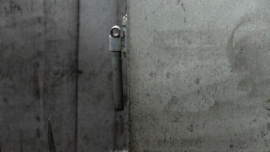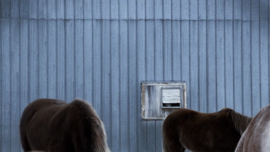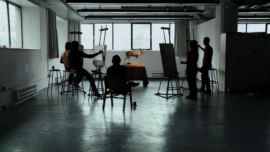Last October, Denis Côté presented his latest film (Que ta joie demeure) at the Festival International du Film Francophone de Namur. During this occasion, the director was also CINEMATEK’s and BOZAR’s guest for a retrospective of his work. Côté’s Bestiare (2013), a dialogue-less film with often stunning observational long takes of mostly animals in a Quebec zoo, was part of the retrospective. A focus on animals is not new: animals have been a part of film history since its inception – we have seen violent images of fighting roosters, elephants being electrocuted, lions hunted down as well as cute and endearing images of “sick” kittens, clever dogs or horses in all kinds of early film genres. Whales, tigers and plenty more dogs (and snakes) as well as the complete animal kingdom have featured in more recent films. We could easily say that far extending the cinema, animals, or rather images of animals, are everywhere in our daily lives. They are a part of our idioms and metaphors, they feature prominently in our children’s books, they are pictured on postcards and calendars, on wallpaper, graphic prints and fabrics, they are on our jewelry and housewares; they are mascots for sports teams, cereals, film studios and theme parks. All these images invite questions about how and why we look at animals and may lead us to speculations about the fate of the animal or its depiction in modern society. It may turn out to be a sad picture, and in fact many culture critics have lamented the decline of the animal in modernity. Yet, I think Côté’s Bestiare offers a slightly different perspective as far as the animal is concerned, so let’s have a closer look at that first.
Denis Côté enjoys describing his films in terms of what they are not and therefore we can start out by noting that Bestiare is not a “documentaire animalaire,” not a behind the scenes at the zoo picture, no educational National Geographic spectacle, not a movie about animal suffering nor one displaying animal cruelty, and certainly not an exercise in anthropomorphism. Instead, Bestiare should be taken as a movie about observation, about looking and gazing, about observers and their objects, and about the thin line between looking at and being looked at. Ultimately, I would argue, it is also about the limits of (human) power and knowledge, both of which we can and often do exert and achieve through our gaze.
To refrain audiences and critics from thinking that he made a “theoretical” film, Côté, who was available for comments after the screening, described Bestiaire as a “jeu d’observation,” as a game, and himself as “cerebral” rather than “intellectual.” If this cerebral quality makes the film at times rather “detached and hard” (his words) it also never becomes polemic or argumentative. (Indeed, the film will not turn you into a vegetarian, it will not make you love animals more or less, and it will probably not make you look differently, as far as ethics are concerned, at zoos.) However, shunning controversy or polemics, Bestiare does count on the interpretative capacities of audiences willing to engage with the longish, slightly off-centered, narratively closed or unforthcoming “Where’s Waldo”-like shots of wildlife. It also depends on the audience’s willingness to take into account conflicting impressions and varying perspectives. The animals are both pitiable and superior. We see humans locked-in in their cars or lemming-like making their way through narrow transparent tunnels, but we are also confronted with animals in tiny or crowded spaces, or strolling around nervously behind fences. As the spatial and emotional perspective shifts we find that at times the animals are locked in just as much as humans are locked out.

Côté’s idea for the film stems from the amusing notion that humans pay money to look at animals in a zoo without realizing that in doing so they consent to be subjected to the animals’ gaze in return. As our gaze is matched with that of the animal, the relationship between observer and subject becomes arbitrary indeed. This notion is surely more than just amusing and despite the director’s non-theoretical (or intellectual, or philosophical, or all too serious) intentions, many of the ideas in the film correspond to central thoughts put forward by art critic and philosopher John Berger – who kind of is theoretical but not dense or difficult – in his well-known 1977 essay, “Why look at Animals?” Here, Berger noted the peculiar effect of the animal gaze when confronted with that of (pre-capitalist, pre-modern) humankind:
“The eyes of an animal when they consider a man [sic] are attentive and wary. The same animal may well look at other species in the same way. He does not reserve a special look for man. But by no other species except man will the animal’s look be recognized as familiar. Other animals are held by the look. Man becomes aware of himself returning the look.” (Berger, 13)
The animal’s gaze is both fascinating and frightening because it points to something unknowable, something beyond comprehension and understanding. Video artist Bill Viola (who in 1986 worked on a series called I don not know what I am like which focused, among other things, on the gaze of the animal) was fascinated with the “irreconcilable otherness of the [animal’s]intelligence” (Viola, quoted in Burt, 41). Indeed, as Berger also observed, there is no “language” – nor any other human strategy such as empathy or logic – to bridge the gap of non-comprehension that separates the animal from the human gaze, there is no way into that otherness. So again, it appears, humans are locked out.
Côté’s significantly dialogue-less film offers a fascinating companion piece to Berger’s essay. Both Côté and Berger look at animals and zoos and they both address and frame the animal from a late capitalist, Western point of view. The animal’s gaze is central to many of the tableaux. Berger’s fine essay culminates with the argument that in our Western culture, defined by corporate capitalism, modern inventions such as zoos, realistic animal toys and the widespread commercial diffusion of animal imagery have converged with the disappearance of the actual animal from our daily lives. The animal has become contained by modernization, mass-production (in the meat industry), and urbanization or replaced by machines, synthetics, and (electronic) toys. (My son has three virtual kittens to pet, wash and feed on his electronic tablet.)
With this separation, Berger traces a spatial and emotional “marginalization” of the actual animal. The animal’s gaze which once looked back at us (and which made us uncomfortable, which mystified us, which fascinated us, which threw us back at ourselves) has become marginal, empty, monotonous, meaningless, because it lacks the space to be and “hence,” Berger asserts, [the animal’s] “assumption of an otherwise exclusively human attitude – indifference.” (In Lives of Animals (1999), J.M. Coetzee’s fictional writer Elizabeth Costello, echoes Berger’s concerns in her lecture about the failure of human empathy and animal suffering, which she compares to particular historical instances of mass destruction and genocide.) Yet, I believe Bestiare is ultimately less pessimistic in that it somehow works against some of Berger’s (and other critics in his wake) conclusions and offers a different reason to look at animals anew.
In calling the animal “indifferent,” Berger of course is not anthropomorphizing (yuk!), but pointing out the colonization of the once exclusively and elusively animal. A post-modern follow up to Berger’s pessimistic thesis (such as to be found in Akira Lippit’s Electic Animal, as noted by Jonathan Burt), is the idea that the animal has by now quite literally disappeared, leaving us with just its spectral residue.
To return to Côté’s animals, we find that there is, indeed, al lot of Berger’s “indifference” or indirectness in the animal’s stares. But there’s more: we also encounter other human-like emotions and attitudes such as nervousness, fear, irritation, restlessness, surprise, and curiosity. Some animals display quirky or inadvertently funny emotions (the nervous lama’s), some are cute (the munching raccoon, a monkey holding on to a stuffed animal toy), and others are familiar and predictable and confirm our common ideas about them (the curious cats, lazy felines, slow buffoons). But, wait, are we not doing what Côté preferred us not to do, i.e. project human emotions on animals, enjoying a game of anthropomorphism? And does this not confirm Berger’s thesis that our increasing distance of the actual animal encourages a process of let’s call it “de-animalization”?

Despite Côté’s qualms, it is difficult and perhaps even pointless to resist understanding the long takes as micro-narratives and to impose causal or emotional scripts on what we see. It is actually quite human to do so, as two of the most typical and enduring strategies for understanding are to narrativize and anthropomorphize. I should also note at this point that the latter should not necessarily be thought of in strictly pejorative terms or as simply naïve, sentimental or something Disney would do (more yuk!). In her short story, Mr and Mrs Dove, Katharine Mansfield lets the main female character tell an anthropomorphic story to explain the impossibility of romance between her and an unattractive but sweet gentleman caller. She compares their situation with two white doves: “ ‘You see,’ explained Anne, ‘the one in front, she’s Mrs Dove. She looks at Mr Dove and gives that little laugh and runs forward, and he follows her, bowing and bowing. And that makes her laugh again. Away she runs, and after her,’ cried Anne, and she sat back on her heels, ‘comes poor Mr Dove, bowing and bowing… and that’s their whole life they never do anything else, you see.’ “ The comparison is both apt and wicked, but it helps to make a painful situation more clear.
Mary Midgley recast the concept of antropomorphism in 1983 in her book Animals and Why they Matter as a useful and commendable (if troubled) tool. She suggested anthropomorphism should be considered as a “power of understanding” which can be successfully applied by “those who want to try to understand animals, and give time and attention to the matter.” As such, those who do “often come to understand them [animals] quite well.” (Midgley, 133). Midgley goes on to quote Donald Griffin, who points out that:
“It is actually no more anthropomorphic, strictly speaking, to postulate mental experiences in another species than to compare its bone structure, nervous system, or anti-bodies with our own…The prevailing view implies that only our species can have any sort of conscious awareness, or that, should animals have mental experiences, they must be identical with ours, since there can be no other kind. It is this conceit which is truly anthropomorphic.” (Midgley, 139)
So, in this reasoning, admitting the possibility of mental states and emotions (or something like it) in animals is a pragmatic and even often successful approach, if one is sincerely concerned with understanding the animal, with bridging that otherness.
After we have accepted our anthropomorphic reflexes, we are likely to observe in Bestiare something else besides indifference or any of the other emotional states summed up above. The film reveals a quality (maybe no less anthropomorphic) of the animal that we seem to have forgotten and which neither capitalism nor any other factor (like imprisonment) has managed to completely destroy: we’ll witness the animal’s full and complete presence in the world. This presence is affirmed from the film’s opening images, which, cunningly, are not of animals at all but consist of close framings of art students. We are close enough to count their facial hairs, to see the pores in their skin, and to see their eyes move rapidly back and forth from sketch to animal. Gradually we discover they are sketching a small deer. A further revelation is that these artists are sketching from a dead, stuffed, example. So, the first animal we see in Bestiaire is a petrified, lifeless creature.

As the film will subsequently illustrate, this taxidermied animal is but the beautiful and craftily obtained copy of its original, strangely similar but radically opposed to the live animal. There is something missing in the taxidermied copy, and it is not indifference. It is entirely devoid of the vibrant energy that exudes from live animals, all of which we will see abundantly in the film’s subsequent long takes. These qualities are restored through Côté’s patient long takes, through the time and space we are allotted to spend with them. The animals in Bestiare intently observe their surroundings and each other, they constantly twist their ears to better perceive the sounds and noises surrounding them, they sniff at the air, their food, their caretakers and each other, they discover and/or claim the (limited) physical space they inhabit. They are there; perceptive, sensuous and alive.
To fully sketch the animal, Côté understands, is to sketch its consciousness, its appraisal of its surroundings, its gaze at the world, whether we are in it or not. By the end of the film, we understand that the art students’ efforts are useless and misguided. (We hear the sound of their avid sketching on the film’s credits but it seems that Côté has by then proven that the real sketch is in the moving picture.) Where Berger’s animals were forced into indifference, Bestiare shows that it is not the animal itself that has become completely indifferent but rather our images of it
A follow up essay will return to zoos (Nell Shipman’s private studio zoo) and to movie animals from silent days to their current CGI replacements.